Ed Blankenheim
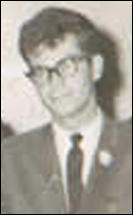
Edward Norval Blankenheim was born Lake Benton, Minnesota, on 16th March, 1934. The family moved to Chicago in 1944. At the age of sixteen he joined the Marine Corps. He later recalled in an unpublished memoir: "It was a time when McCarthyism flourished. We all hated communists and a few of us would have the opportunity to kill many in the name of Freedom." (1)
Blankenheim later told Clayborne Carson: "I'd joined the Marine Corps when I was 16 and we were told that the armed forces at that time were integrated. It is true, they were integrated, but that didn't carry over into the civilian population. A very good friend of mine and I wanted to leave the base in North Carolina and go into town for a few beers. When we got to the main gate, the driver of the bus pulled over to the bus turnaround area and said, 'Okay, all you N******* get to the back of the bus.' I couldn't believe it, and neither could my friend. He was mortified... The driver came up and put his finger right in his chest and said 'I'm talking to you N*******, get in the back of the bus.' I was livid, I don't know what I woulda done. The bus driver put his hand out the window and on board the bus came two MP's, one black and one white. They said that they had a card that said United States Marine Corps, guests of the state of North Carolina and we will honor their customs. And I went ballistic and there was nothing we could do." (2)
Ed Blankenheim and Civil Rights
Blankenheim left the Marine Corps and moved to Tucson and studied chemistry at the University of Arizona. He joined the local branch of the National Association for the Advancement of Colored People (NAACP). He also became active in the Congress on Racial Equality (CORE). Members were mainly pacifists who had been deeply influenced by Henry David Thoreau and the teachings of Mahatma Gandhi and the nonviolent civil disobedience campaign that he used successfully against British rule in India. CORE became convinced that the same methods could be employed by blacks to obtain civil rights in America. (3)
Blankenheim became involved in the campaign while he was at university. In the student union building, he wrote, “there were always 20 or 30 black students in the cafeteria. It seemed strange that they would be in a small corner of the room, so I decided to find out why. I began to take coffee with them. The group was suspicious at first, but I was able to gradually gain their trust. Tom Burroughs, a graduate student in chemistry and a person of color, was the first to open up. He said that the black students were harassed on campus and felt very threatened. He said that he and a small group of undergraduates were forming a group called Students for Equality. He was worried about his teaching assistantship because the college administration was very conservative. But he felt obliged to take a leadership role in combating racial intolerance. He could not live with the kind of hatred directed at him simply because he was a black man. Tom had made his choice and for him, there was no turning back. There could be no fence-sitting. I felt obliged to join him." (4)
Freedom Rides
In February, 1961, CORE organized a conference in Kentucky where the organization laid out its plans to have Freedom Riders challenge the racist policies in the south. It was decided they would ride interstate buses in the South in mixed racial groups to challenge local laws or customs that enforced segregation in seating. (5) John Lewis, a student at Nashville American Baptist Theological Seminary, commented later: "At this time human dignity is the most important thing in my life. This is the most important decision in my life, to decide to give up all if necessary for the Freedom Ride, that Justice and Freedom might come to the Deep South." (6)
Blankenheim decided to volunteer to become a Freedom Rider and he was one of those selected to travel on the first bus. James Farmer and his staff at CORE tried to come up with a reasonably balanced mixture of black and white, young and old, religious and secular, Northern and Southern. The only deliberate imbalance was a lack of women. The CORE leadership was reluctant to expose women, especially black women, to potentially violent confrontations with white supremacists. "Their decision to limit the number of female Freedom Riders to two was undoubtedly rooted in patriarchal conservatism, but they also feared that a balanced contingent of men and women might be interpreted as a provocative pattern of sexual pairing. The situation was dangerous enough, they reasoned, without taunting the segregationists with visions of interracial sex." (7)
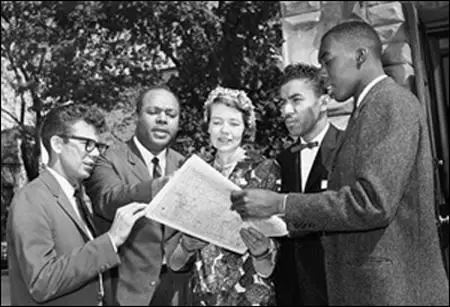
Benjamin Elton Cox and Hank Thomas discussing proposed Freedom Rides
Walter Bergman was another white man selected to become a Freedom Rider: "Fourteen of us went into training for three days in nonviolent techniques, Gandhi - and Martin Luther King Jr. - type techniques. We had to be absolutely nonviolent, no matter what happened to us. On the last day, the leader, James Farmer, asked, 'Will each of you under all circumstances, no matter what the provocation, refrain from reacting violently?' I was sixty at the time, and it wasn't too difficult for me to say I'd be nonviolent. But there was one young man (John Moody), a big football player, who said, 'I don't know. If some southern sheriff comes up and tells me that I've got to move along and starts to shove me, I just can't say that I won't shove back.' So James Farmer said, 'Well, we'll have to leave you behind.' That made only thirteen of us, six whites and seven Blacks." (8)
The first bus left Washington on 4th May, 1961, for Georgia, Alabama and Mississippi. Members of CORE who traveled on the bus included Ed Blankenheim, John Lewis, James Peck, Hank Thomas, Walter Bergman, Frances Bergman, Genevieve Hughes, James Farmer, Benjamin Elton Cox, Charles Person and Jimmy McDonald. Farmer later recalled: "We were told that the racists, the segregationists, would go to any extent to hold the line on segregation in interstate travel. So when we began the ride I think all of us were prepared for as much violence as could be thrown at us. We were prepared for the possibility of death." (9)
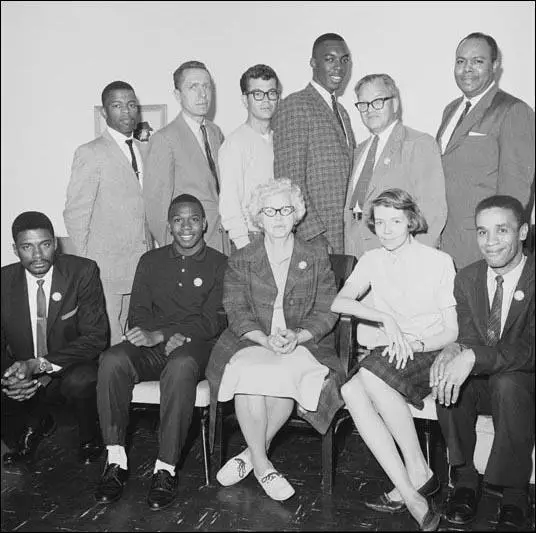
John Lewis, James Peck, Ed Blankenheim, Hank Thomas, Walter Bergman
and James Farmer. Bottom, left to right: Benjamin Elton Cox, Charles Person,
Frances Bergman, Genevieve Hughes and Jimmy McDonald.
They traveled in integrated seating and visited "white only" restaurants. Governor John Malcolm Patterson of Alabama who had been swept to victory in 1958 on a stridently white supremacist platform, commented that: "The people of Alabama are so enraged that I cannot guarantee protection for this bunch of rabble-rousers." Patterson, who had been elected with the support of the Ku Klux Klan added that integration would come to Alabama only "over my dead body." (10) In his inaugural address Patterson declared: "I will oppose with every ounce of energy I possess and will use every power at my command to prevent any mixing of white and Negro races in the classrooms of this state." (11)
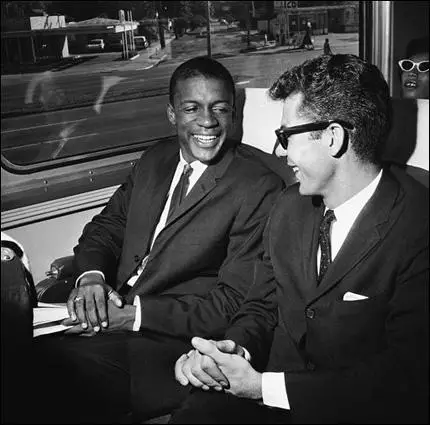
The Birmingham, Police Commissioner, Bull Connor, organized violence against the Freedom Riders with local Ku Klux Klan groups. Gary Thomas Rowe, an FBI informer, and a member of the KKK, reported to his case officer that the mob would have fifteen minutes to attack the Freedom Riders without any arrests being made. Connor said he wanted the Riders to be beaten until "it looked like a bulldog got a hold of them." It was later revealed that J. Edgar Hoover knew the plans for the attack on the Freedom Riders in advance and took no action to prevent the violence. (12)
Anniston
On 14th May, 1961, a mob of Klansmen, attacked the bus at Anniston, Alabama. Albert Bigelow later explained: "Our bus, approaching Anniston, stopped while our driver conversed with the driver of an outgoing bus. A traveler from the bus leaving Anniston station. Outside, no police were in sight. During the fifteen minutes in Anniston, while the mob slashed tires and smashed windows, one policeman appeared in a brown uniform. He did nothing to stop vandalism but fraternized with the mob. A man in a white overall with a dark blue oval insignia on the breast was friendly with the policemen and consulted from time to time with the most active of the mob. Two policemen appeared and cleared a path. The bus left the station. There were no arrests. A few miles out on the highway to Birmingham a tire blow and we pulled to the roadside, the mob after us in about 50 cars. They surrounded us again, yelling and smashing windows, brandishing clubs, chains and pipes; I saw all three." (13)
Some, having just come from church, were dressed in their Sunday best. Ed Blankenheim later recalled: "As a matter of fact, one of the white men who boarded the bus said, 'Y'all ain't in Georgia now, y'all in Alabama.' And with that, he eventually set the bus on fire which was not a good place to be at the time. They held the door shut for maybe ten minutes, they held the door shut... The mob surrounded the bus. The cops would not let the mob get on the bus. So they threw an incendiary device aboard... They were mighty angry people. Really, really vicious. They, as I said, they did surround the bus. They threw a fire bomb aboard and held the door closed. One of the tanks blew up. One of the gas tanks blew up and Hank Thomas, who was one of the Freedom Riders, took advantage of it and was able to force open the bus door, thereby we got off. When we did get off... we had to run through the... these racists who beat us all like hell. Fortunately, well it didn't sound fortunate, the second fuel tank on the bus exploded, scared the hell out of the mob so they uh went on the other side of the highway and the object was to leave us there where we would be blown up." (14)
When the Freedom Riders left the bus they were attacked by baseball bats and iron bars. Genevieve Hughes said she would have been killed but an exploding fuel tank convinced the mob that the whole bus was about to explode and the white bomb retreated. Eventually they were rescued by local police but no attempt was made to identify or arrest those responsible for the assault. (15)
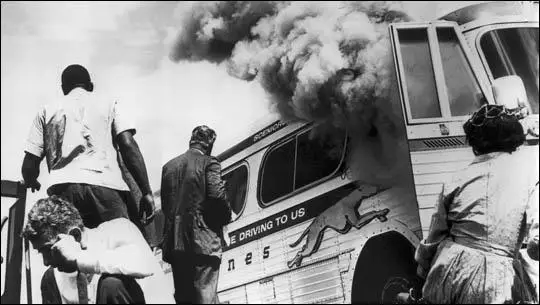
Blankenheim pointed out that: "At the very last moment, an ambulance came and took us to the hospital in Anniston Alabama. There the mob surrounded the bus. They gave the hospital administrators one hour, to let us, to get us out into the parking lot to the mob... Genevieve Hughes and I were the first ones hospitalized because we had pretty weak lungs. We found out all of us couldn't be hospitalized because they don't take blacks in Alabama into the hospital. We refused to go to our rooms and went down to the emergency room with the rest of the Freedom Riders." (16)
Genevieve Hughes added. "They admitted me into a ward like room not a private room which is what they had in those days and all the black people were kept on gurneys out in in the corridor they were not admitted to the hospital in any formal since nobody had any injuries that I knew of except for smoke inhalation which was fairly serious but more for me because the smoke bomb had been placed in the seat right opposite of mine and I had probably breathed more smoke than anybody else." (17)
Reverend Fred Shuttlesworth of Birmingham had heard about the problems of the Freedom Riders and "he sent 15 or 20 cars down to the parking lot to get us out. As they come in at about 50 miles per hour, screech to a halt, and one or two Freedom Riders would get out and we sped away from there.... After that, we were hidden in houses in Birmingham until the next day where we again assembled outside of Reverend Shuttlesworth's house and we made our way to the bus station. After several hours... we could not get out of there because not a bus driver would drive the bus. So we went to the airport so we could fly to Montgomery, which was our next stop. Well they they cut us off there too, and threatened to blow up the plane if we get on. Finally, Robert Kennedy was frightened enough so that he sent down a man - I can't remember his name - and some Federal Marshals. They searched the United Airlines plane and determined there were no explosives aboard. The assistant attorney general had to get on. One of the conditions was that the attorney general had to fly out with us and prove that there was no bomb on the plane." (18)

On 24th May, 1961, Ed Blankenheim joined with James Farmer, John Lewis, Doris Jean Castle, John Moody, Jerome Smith, Peter M. Ackerberg, Lucretia R. Collins, John Lee Copeland, Dion Tyrone Diamond, Grady H. Donald, Frank George Holloway, Ernest Patton, Hank Thomas, Clarence Lloyd Thomas and Leroy Glenn Wright traveled from Montgomery, Alabama, to Jackson, Mississippi. (19) Castle told Keith Weldon Medley: “Those on the bus with us were a group of people who had never been in each other’s company, bonded by a common goal. Our only weapon was that we were right in what we were doing.” (20)
End to Transport Segregation
The Freedom Riders intended to move their protest to Mississippi. President John F. Kennedy made one last attempt to stop this happening and telephoned Martin Luther King to call-off the action and persuade them to post bonds so that they could leave prison. King replied: "It's a matter of conscience and morality. They must use their lives and bodies to right a wrong. Our conscience tells us that the law is wrong and we must resist, but we have a moral obligation to accept the penalty." Kennedy insisted: "That is not going to have the slightest effect on what the government is going to do in this field or any other. The fact that they stay in jail is not going to have the slightest effect on me." (21)
The media was to play an important role in changing the attitudes of the Kennedy administration. On the first bus that left Montgomery for Jackson, Mississippi, on 24th May, 1961, the 12 Freedom Riders led by James Lawson, were joined by members of the National Guard and several journalists. The second bus the Freedom Riders were led by John Lewis and the third bus by the Baptist minister, John Lee Copeland. The following day the fourth bus left Montgomery. Those on board included three Baptist ministers, Ralph Abernathy, Fred Shuttlesworth, Wyatt Tee Walker and William Sloane Coffin, chaplain of Yale University. (22)
When the buses arrived at the Jackson Terminal, the Freedom Riders, black and white, went into the white waiting room. Several also used the white rest-room. They were immediately arrested. They refused an offer by NAACP attorneys to post a thousand-dollar bond for each defendant. When the Baptist minister, Ralph Abernathy was asked about Robert Kennedy's complaint that the Freedom Riders were embarrassing the nation in front of the world, he responded: "Well doesn't the Attorney General know we've been embarrassed all our lives?" (23)
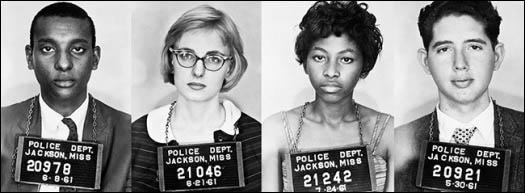
During the summer of 1961 freedom riders also campaigned against other forms of racial discrimination. They sat together, in segregated restaurants, lunch counters and hotels. This was especially effective when it concerned large companies who, fearing boycotts in the North, began to desegregate their businesses. Norman Thomas described these young people as "secular saints" (24) I. F. Stone argued: "They and a few white sympathizers as youthful and devoted as themselves have begun a social revolution in the South with their sit-ins and their Freedom Rides. Never has a tinier minority done more for the liberation of a whole people than these few youngsters of C.O.R.E. (Congress for Racial Equality) and S.N.C.C. (Student Non-Violent Coordinating Committee)." (25)
Martin Luther King claimed that he "hundred of thousands" of students willing to travel to the Deep South to join the protests. The administration decided it had to take action. Robert Kennedy now petitioned the Interstate Commerce Commission (ICC) to draft regulations to end racial segregation in bus terminals. The ICC was reluctant but in September 1961 it issued the necessary orders and it went into effect on 1st November. However, James Lawson, one of the Freedom Riders, argued: "We must recognize that we are merely in the prelude to revolution, the beginning, not the end, not even the middle. I do not wish to minimize the gains we have made thus far. But it would be well to recognize that we have been receiving concessions, not real changes. The sit-ins won concessions, not structural changes; the Freedom Rides won great concessions, but not real change." (26)
Later Life
For the next couple of years Ed Blankenheim spent him time touring the Deep South. "Finally I was burned out and I moved my family to Hawaii. But even there we weren't safe from demonstrations. As it turns out, there is a colony of lepers on Molokai. People who have victims, were victims of leprosy do not want to be called lepers. They insist on Hanson's disease. Well, we got involved there to the state tried to throw them out there in 22 acres. I the center of Honolulu and when they were told that they had to go back to Molokai, they said 'No', they wouldn't, they had read... Martin Luther King's, literature and they somehow got the courage to say 'No', they wouldn't go. What resulted was they were thrown in jail and they had a lot of nine year fights through the courts and just about three years ago I think they won the battle... It was a quite sweet, sweet victory." (27)
Ed and Pam Blankenheim moved to San Francisco. Ed was employed as a carpenter whereas Pam worked for the law firm Leland Parachini. In later years he suffered poor health and died, aged 70, of cancer on 26th September, 2004. (28)
Primary Sources
(1) Raymond Arsenault, Freedom Riders (2006)
Ed Blankenheim was a carpenter's apprentice and part-time chemistry student at the University of Arizona in Tucson. Feisty and full of resolve, he talked his way into the Marine Corps in 1950, at the age of sixteen. Eleven years later, as a Korean War veteran and father of two, he traveled more than two thousand miles to join the Freedom Rider. Born in Minnesota and raised in Illinois, he moved to Arizona in the late 1950s, after spending two years at Wright Junior College in Chicago. Befriending fellow chemistry student Tom Burroughs and several other black student activists, he became one of the few whites to participate in local civil rights activities, first as a member of Tucson's NAACP Youth Council, and later as a leader of a local CORE chapter known as Students for Equality. The CORE affiliation came after Blankenheim and Burroughs called the New York office for help.
(2) Ed Blankenheimand, interviewed by Clayborne Carson (2nd March, 2002)
I'd joined the Marine Corps when I was 16 and we were told that the armed forces at that time were integrated. It is true, they were integrated, but that didn't carry over into the civilian population. A very good friend of mine and I wanted to leave the base in North Carolina and go into town for a few beers. When we got to the main gate, the driver of the bus pulled over to the bus turnaround area and said, "Okay, all you N******* get to the back of the bus." I couldn't believe it, and neither could my friend. He was mortified.
No way I ... the driver came up and put his finger right in his chest and said "I'm talking to you N*******, get in the back of the bus." I was livid, I don't know what I woulda done. The bus driver put his hand out the window and on board the bus came two MP's, one black and one white. They said that they had a card that said United States Marine Corps, guests of the state of North Carolina and we will honor their customs. And I went ballistic and there was nothing we could do. And that stayed with me for about 7 years I guess, when I heard about the freedom rides and it was a chance to do something when I, when we couldn't do anything 7 years earlier so I jumped at the chance when it carne.
I joined the Freedom Ride from Tucson, Arizona, where I was going to school. I answered the call of Jim Farmer who joined the Freedom Rides on, Mother's Day of 1961. We had a very successful trip to the South until we got to Alabama. As a matter of fact, one of the white men who boarded the bus said, "Y'all ain't in Georgia now, y'all in Alabama." And with that, he eventually set the bus on fire which was not a good place to be at the time. They held the door shut for maybe ten minutes, they held the door shut.... The mob surrounded the bus. The cops would not let the mob get on the bus. So they threw an incendiary device aboard... They were mighty angry people. Really, really vicious. They, as I said, they did surround the bus. They threw a fire bomb aboard and held the door closed. One of the tanks blew up. One of the gas tanks blew up and Hank Thomas, who was one of the Freedom Riders, took advantage of it and was able to force open the bus door, thereby we got off. When we did get off, , we had to run through the... these racists who beat us all like hell. Fortunately, well it didn't sound fortunate, the second fuel tank on the bus exploded, scared the hell out of the mob so they uh went on the other side of the highway and the object was to leave us there where we would be blown up. At the very last moment, an ambulance came and took us to the hospital in Anniston Alabama. There the mob surrounded the bus. They gave the hospital administrators one hour, to let us, to get us out into the parking lot to the mob.
Genevieve Hughes and I were the first ones hospitalized because we had pretty weak lungs. We found out all of us couldn't be hospitalized because they don't take blacks in Alabama into the hospital. We refused to go to our rooms and went down to the emergency room with the rest of the Freedom Riders. ... Anyway, Reverend Fred Shuttlesworth of Birmingham had heard about our plight and he sent 15 or 20 cars down to the parking lot to get us out. As they come in at about 50 miles per hour, screech to a halt, and one or two Freedom Riders would get out and we sped away from there.
After that, we were hidden in houses in Birmingham until the next day where we again assembled outside of Reverend Shuttlesworth's house and we made our way to the bus station. After several hours... we could not get out of there because not a bus driver would drive the bus. So we went to the airport so we could fly to Montgomery, which was our next stop. Well they they cut us off there too, and threatened to blow up the plane if we get on. Finally, Robert Kennedy was frightened enough so that he sent down a man - I can't remember his name - and some Federal Marshals. They searched the United Airlines plane and determined there were no explosives aboard. The assistant attorney general had to get on. One of the conditions was that the attorney general had to fly out with us and prove that there was no bomb on the plane. That is exactly what happened...
We couldn't get to Montgomery. By that time it was too late to get to Montgomery. We tried to get to New Orleans and as a matter of fact we did. They flew us to New Orleans where we had a huge rally and everyone pretty much thought that the Freedom Rides were over.
Well they hadn't counted on the spirit of CORE and SNCC at that time. People from the Southern colleges, and Jim Farmer, our national director just went and filled the jails in Jackson Mississippi and by doing that we were able to break the back of Mississippi. They finally, after a tremendous battle, they finally gave in and the segregation of the bus stations in the south were integrated.
It made me a life time fighter for civil rights. I worked for a while in the south testing the bus stations to make certain that they were following the law. And then I went and worked in Chicago for, just about 10 years. Finally I was burned out and I moved my family to Hawaii. But even there we weren't safe from demonstrations. As it turns out, there is a colony of lepers on Molokai. People who have victims, were victims of leprosy do not want to be called lepers. They insist on Hanson's disease. Well, we got involved there to the state tried to throw them out there in 22 acres. I the center of Honolulu and when they were told that they had to go back to Molokai, they said "No", they wouldn't, they had read... Martin Luther King's, literature and they somehow got the courage to say "No", they wouldn't go.
What resulted was they were thrown in jail and they had a lot of nine year fights through the courts and just about three years ago I think they won the battle and the state turned the land over to where I think 50 I think 50 duplex condominiums on the land. It was a quite sweet, sweet victory and as of late especially uh now that I'm handicaped. If I go to demonstrations and the rest of the couple of times the handicap people can't get on the greyhound busses and by golly we turned them around too. Well that's about my life in a nutshell.
(3) Richard Knee, The San Francisco Bay Guardian (29th September, 2004)
Whenever someone told Ed Blankenheim he didn’t have to risk life and limb in the cause of civil rights, he would vehemently disagree Henry “Hank” Thomas had just such a conversation with Blankenheim last October, when they and the two other surviving civil-rights activists known as the Freedom Riders participated in a panel discussion at the University of Illinois.
Blankenheim was not in the best of shape, and both men knew it might be the last time they’d be together, Thomas recalled. Blankenheim had traveled there from San Francisco, Thomas from Stone Mountain, Ga.
“I said to him publicly how much I appreciated him, for doing all he’d done when he didn’t have to,” Thomas said.
At that point, Thomas said, Blankenheim launched into the story of his first encounters with racial segregation, in the early 1950s: he was a marine, stationed at Camp Lejeune, N.C., and had become friends with a black man. On base, the two were treated as equals, but whenever they went into nearby Jacksonville, separation became the rule.“He cried, because there was nothing he could do,” Thomas said. Blankenheim wanted to challenge the status quo, “but his friend said, ‘Hey, don’t do it.’ It just tore him up inside. So, he told me, ‘Hank, don’t ever say, “I didn’t have to do it.”
Blankenheim, Thomas and 11 others did indeed risk life and limb in the early 1960s to desegregate lunch counters, bus stations, restrooms and other public facilities in Virginia, the Carolinas, Georgia, Alabama, Louisiana and Mississippi. Three of them, or maybe six, remain.
Blankenheim died Sunday, Sept. 26, of cancer. He was 70.
The other known survivors from that core group are U.S. Rep. John Lewis (D-Ga.) and the Rev. Benjamin Cox of Jackson, Tenn. Cox said three of the Freedom Riders went into hiding several years ago and have not been located.
Edward Norval Blankenheim was born March 16, 1934, in Lake Benton, Minn., and moved with his family to Chicago at age 10. At 15, according to Pam Blankenheim, he lied about his age to join the Marine Corps, going first to Paris Island, S.C., and then to Camp Lejeune.
“It was a time when McCarthyism flourished,” he said in an unpublished memoir, Freedom Ride.“We all hated communists and a few of us would have the opportunity to kill many in the name of Freedom."
“Harry Truman had just given an executive order ending racial discrimination in the armed forces. To Mr. Truman’s credit, that order was immediately obeyed. It did not, however, extend to the civilian population. So you had this dichotomy; you could have black friends on base but because of racial policies in the South, blacks and whites could not go into town together. Blacks had to ride in the back of the bus. Off base, the Marine Corps maintained separate police forces. Black MPs patrolled ‘dark town,’ which is where the troops of color went for their ‘liberty.’ White MPs in the white part of town policed white troops.”
“Many of us, both black and white, hated this system but there didn’t seem to be anything that we could do about it. We knew of no such thing as a civil rights organization beyond the NAACP (National Association for the Advancement of Colored People) and in the early ’50s, they were not able to tackle a problem of this magnitude. We just went along.”
Blankenheim was drawn into the civil rights movement “quite by accident” during his senior year at the University of Arizona, where he had transferred from Wright College in Chicago, intending to pursue a post-graduate degree in chemistry.
In the student union building, he wrote, “there were always 20 or 30 black students in the cafeteria. It seemed strange that they would be in a small corner of the room, so I decided to find out why. I began to take coffee with them. The group was suspicious at first, but I was able to gradually gain their trust.
“Tom Burroughs, a graduate student in chemistry and a person of color, was the first to open up. He said that the black students were harassed on campus and felt very threatened. He said that he and a small group of undergraduates were forming a group called Students for Equality. He was worried about his teaching assistantship because the college administration was very conservative. But he felt obliged to take a leadership role in combating racial intolerance. He could not live with the kind of hatred directed at him simply because he was a black man. Tom had made his choice and for him, there was no turning back. There could be no fence-sitting. I felt obliged to join him. …
“So when Tom Burroughs explained CORE (Congress of Racial Equality), we both felt that we had found a way to contribute something of ourselves to the fledgling civil rights movement.”
The original 13 Freedom Riders first came together at a meeting in a Quaker house in Washington in April 1961. CORE had called the gathering specifically to plan for a Freedom Ride from Washington to New Orleans, Cox said.
Blankenheim was, Cox said, “one of those few thousand whites who worked for the American dream - liberty and justice for all. He protested nuclear weapons and racial segregation… Ed was one of those who stuck his neck out when he didn’t have to.”While Blankenheim called himself an atheist, “I’d say he was more of an agnostic,” Cox said. “At dinner in his house, I’d say table grace and he would never reject it. He had a big heart for all people and for justice.”
What Thomas remembers most about Blankenheim was his sense of humor. “During all of what was a very difficult and dangerous time, Ed could always find something funny,” Thomas said.
“Ed looked like a mixture of several things - Italian, Jewish and, being from Arizona, he had a pretty deep tan.
The only time Blankenheim’s sense of humor abandoned him, Thomas said, was when they were in Anniston, Ala., and an angry, hate-filled mob forced their bus to stop, broke its windows and set it ablaze. “We were all suffering from smoke inhalation,” Thomas said. “We weren’t sure we’d make it out of there alive, and Ed said he, too, had made peace with himself.”
In fairness, I’ll inform readers here that I’ve been friends with the Blankenheims for the past several years. This is because my wife, Carolyn, works with Pam Blankenheim, at the San Francisco law firm Leland Parachini.
It’s a close-knit group there, much like family, which is why Carolyn continues after her retirement to work there part time. Everyone there loves Pam and Ed, so when Pam got the news that Ed’s cancer was terminal, her co-workers decided to donate some of their vacation time to her so she could have some extra paid time to care for him, Carolyn told me.
“One of our associate attorneys gave Pam an entire week,” and Carolyn herself gave Pam a day, she said.
When I last saw Ed, a few months ago, I suggested that we shake hands left-handed. I didn’t have to explain it to him, and he smiled broadly as our hands gripped tightly.I’ve been active for many years on First Amendment issues, and I like to think I’ve contributed something to the cause. And then I think about Ed Blankenheim and his 12 fellow Freedom Riders, who lived the First and several other amendments, and nearly died doing so.
And millions of Americans are better off for it.
“We were glad we had the opportunity to change this country,” Thomas said. “He will always be my hero.”
Amen.Blankenheim leaves his wife, Pam; a son, Matthew, of Santa Rosa; daughters Leslie Angeline of Santa Rosa and Alyn Herfurt of Cloverdale; grandchildren Joshua Boyne of San Francisco, and Matthew, Danielle and Kristopher Blankenheim, all of Cloverdale; and sisters Sharon Guyette of Buffalo Grove, Ill., and Donna Bennett of Chandler, Ariz. He was preceded in death by brothers Warren, Clayton and Daniel, and sisters Myla Turner and Audrey Ruther.
A memorial service is slated this Sunday at 2 p.m. in the Screening Room of the Delancey Street Restaurant, 600 The Embarcadero, San Francisco. Donations in Blankenheim’s memory may go to the Southern Poverty Law Center, 400 Washington Ave., Montgomery, AL 36104.
